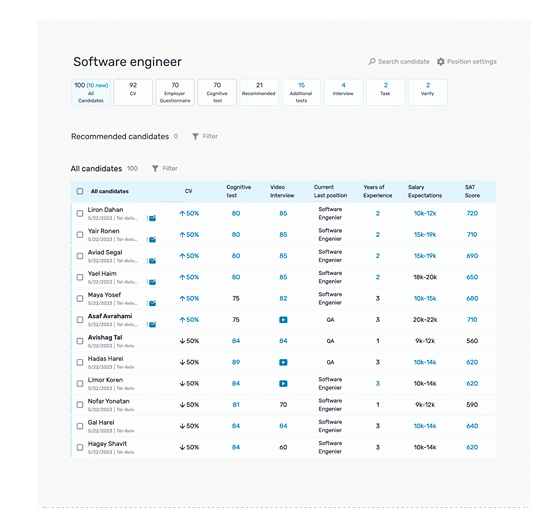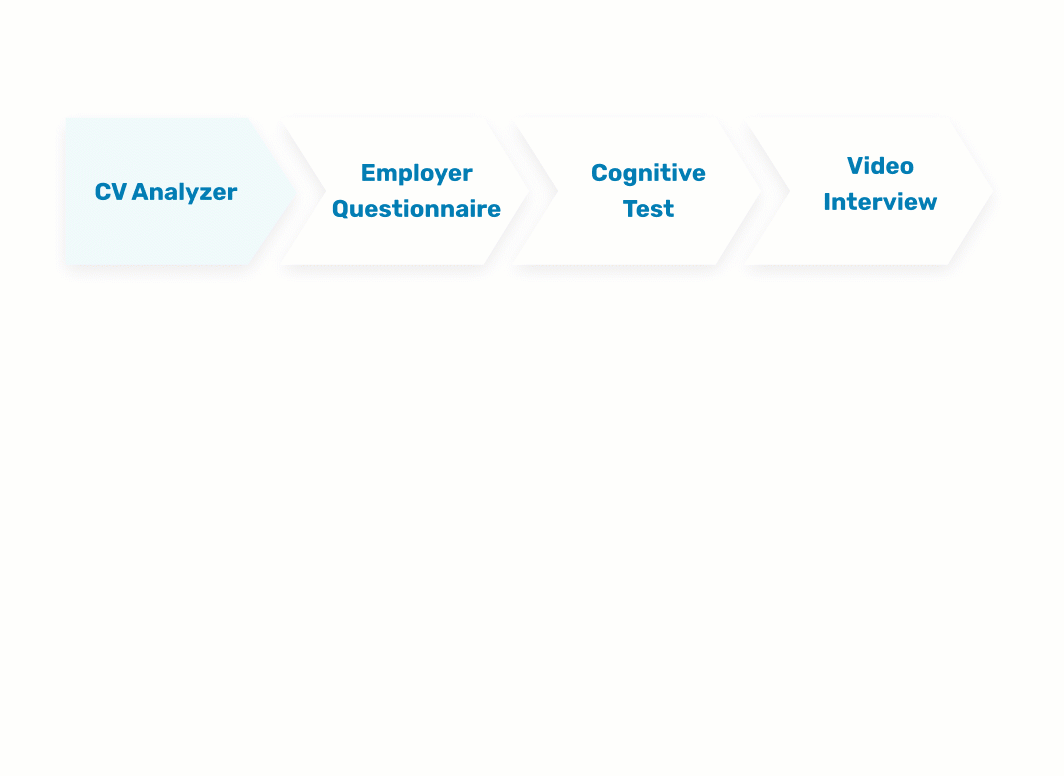 How to Choose the Right Recruitment Software for Your Business in 2025
How to Choose the Right Recruitment Software for Your Business in 2025
Recruitment software is pivotal in modern hiring, empowering HR professionals, hiring teams, and staffing agencies to find quality applicants quickly and efficiently. By automating manual tasks like job postings, resume screening, candidate assessments, and interview scheduling, recruitment software saves valuable time and enhances the candidate experience. Let’s explore how to select the perfect recruitment tool tailored to your recruitment process, business needs, and hiring strategy.
Types of Recruitment Software
Applicant Tracking System (ATS)
An applicant tracking system is a recruitment tool that automates candidate sourcing, tracking, and evaluation. ATS systems manage job postings, filter resumes based on predefined criteria, and handle candidate communication through email integration. They are also based on AI tools, which provide data-driven insights for better-informed decisions regarding top candidates.
Candidate Relationship Management (CRM)
A recruitment CRM focuses on nurturing potential candidates and building long-term relationships. With features like marketing automation, personalized emails, candidate management, and talent pool creation, CRM software helps recruitment businesses attract and retain top talent.
Tips for Selecting the Best Recruitment Software:
Choosing the right recruitment software can feel overwhelming, especially with so many options. Here are critical factors to consider:
1. Flexible Customization Options
Your hiring process is unique, so your recruitment software should be customizable. Look for solutions that adapt to your specific roles, existing tools, and workflows. Customization ensures scalability, supports your company culture, and helps you manage compliance seamlessly.
2. User-Friendly Interface
An intuitive, user-friendly interface is essential for productivity. Complex processes become incredibly easy when recruitment software offers drag-and-drop features, clear navigation, and straightforward design. This reduces the learning curve for new users and saves hard work.
3. Data Security Protections
Recruitment involves handling sensitive candidate data, from resumes to background checks. Ensure your chosen recruitment software offers robust security measures like encryption, access controls, and email communication protection to build trust with candidates and hiring managers.
4. Automated Job Posting Across Multiple Job Boards
Recruitment software should make it easy to post open positions on multiple job boards and social media platforms. Centralized job postings save time and ensure a consistent employer brand across job descriptions on every platform.
5. Integration with Existing Tech Stack
Your recruitment tool must seamlessly integrate with your current tech stack, such as HR software, email integration, and video conferencing platforms. This ensures a smooth workflow for hiring teams and eliminates the need to switch between other platforms.
6. Budget and Scalability
While it’s tempting to go for feature-rich solutions, it’s essential to stay within your budget. Assess your business needs, the number of open positions, and the size of your small business or hiring team. Look for recruitment software that offers long-term value, scalability, and flexible payment plans.
Why Recruitment Software is a Game-Changer
Recruitment software eliminates the manual work associated with traditional hiring processes, saving valuable time for hiring managers and small teams. By focusing on candidate screening, applicant tracking, and recruitment CRM, these tools ensure you find the best people for your open jobs efficiently.
With features like offer letters, mobile device access, predictive analytics, and email integration, recruitment software is the perfect solution for hiring teams aiming to improve productivity while delivering a stellar candidate experience. Whether you're managing multiple countries or filling roles for a small business, these tools help you stay ahead in a competitive market.
Practical Solutions for Recruitment Challenges
Recruitment software addresses complex processes with innovative solutions, making it easier for organizations to manage hiring needs across multiple countries or handle specialized recruitment for specific industries.
- Support Team: A reliable customer support team and customer success team can help resolve issues efficiently, ensuring smooth operations throughout the recruitment process.
- Save Time: Automate manual tasks such as resume sorting, candidate outreach, and email follow-ups to focus on evaluating top candidates and making impactful hiring decisions.
- .Manage Compliance: Recruitment software helps organizations manage compliance, ensuring candidate data aligns with legal and ethical standards, avoiding complications, and building trust.
- Improve Productivity: Centralized tools like email integration, time tracking, and intuitive dashboards enhance efficiency, allowing hiring teams to focus on critical aspects of the hiring process.
Streamlining Recruitment Software Implementation
Selecting and implementing recruitment software can significantly improve your hiring process. With features like seamless integration with your tech stack, centralized candidate communication, and tailored workflows, these tools provide the foundation for a successful recruitment strategy.
- Easy Onboarding: Many recruitment solutions are designed for new users, featuring user-friendly interfaces that minimize training time and increase adoption.
- Stay Ahead: Leverage the latest product updates to keep your system running smoothly and ensure your hiring team can identify and attract the best candidates for open roles.
- Informed Decisions: Features like data-driven insights and predictive analytics allow organizations to refine their recruitment strategies and make better hiring decisions.
By embracing these solutions, businesses can streamline their operations, attract quality applicants, and foster long-term success in their recruitment efforts.
Let's Talk Straight: The Advantages of Our Recruitment System
We've reviewed all the theoretical ways to choose the most efficient recruitment software to make the hiring processes proficient, convenient, and fast. Now it's time to turn those theories into practical solutions for your organisation.
Introducing AI Recruitment, the recruitment system by Noam Institute, set to enhance your hiring experience for both recruiters and candidates. How does it work?
- Reach the Best Candidates First: Receive precise and quick data to identify the leading and most suitable candidates even before the first phone call.
- Manage All Recruitment Processes in One Place: Publish job openings across relevant platforms with a single click and get an up-to-date overview of all your recruitment processes via the dashboard. Recruiters, department managers, and team leaders have access to candidate details, test results, reviews, and recommendations. They can add their impressions and track the process in real-time.
- Enhance the Candidate Experience: Create a smooth and upgraded screening experience for candidates, offering full transparency about their status in the recruitment process. This reduces the risk of missing out on top candidates or letting them fall through the cracks. It also turns your recruitment process into a well-organised, pleasant, and inviting business card for your organisation.
- Take Recruitment to the Next Level: Integrate innovative features like automated screening stages, AI-based CV scanning, custom cognitive assessments, and top candidate ranking to achieve better results in less time.


FAQs
Recruitment software, such as ATS (Applicant Tracking Systems), is designed to streamline and manage the hiring process. It automates tasks such as posting job openings, collecting and organising resumes, screening candidates based on skills and qualifications, and scheduling interviews. ATS integrates features for centralised communication with candidates and provides reporting and analytics to enhance recruitment efficiency.
Overall, recruitment software and ATS help improve the effectiveness of hiring by automating routine tasks and providing valuable insights into the recruitment process.
Recruitment software and ATS (Applicant Tracking Systems) are closely related but not always the same. While ATS is a type of recruitment software specifically designed to manage the recruitment process, including posting jobs, tracking candidates, and automating resume screening, recruitment software can encompass a broader range of tools. Recruitment software may include ATS functionalities but can also integrate other features such as candidate relationship management, onboarding, and recruitment marketing. In essence, all ATS are recruitment software, but not all recruitment software is limited to ATS functions.
The difference between ATS (Applicant Tracking Systems) and recruitment software lies in their scope and functionalities:
- ATS (Applicant Tracking System): An ATS is a type of recruitment software focused on managing and streamlining the hiring process. It automates job posting, resume collection, candidate screening, tracking applications through various stages, and facilitating communication with candidates. Its primary purpose is to efficiently handle the flow of job applicants and ensure an organised recruitment process.
- Recruitment Software: This term encompasses a wide array of tools and systems designed to support various aspects of recruitment. It not only includes ATS functionalities but also integrates additional features such as recruitment marketing, candidate relationship management (CRM), onboarding, and analytics. This comprehensive approach allows it to manage the entire recruitment lifecycle and includes tools for improving employer branding, engaging with passive candidates, and managing talent pools.
ATS (Applicant Tracking System): Manages the hiring process by automating tasks like resume screening, job postings, and candidate tracking.
CRM (Candidate Relationship Management): Focuses on building relationships with candidates, using tools like personalized emails and nurturing a talent pool for future hiring.
The best software combines ATS and CRM features, offering customization, integration with job boards, and a user-friendly interface.
Look for tools that improve time-to-hire, enhance candidate experience, and support your recruitment strategy with data-driven insights.
Yes, modern recruitment software integrates seamlessly with HR software, social media platforms, and other tech stack elements.
By offering transparent updates, automating repetitive tasks, and ensuring personalized interactions, recruitment software enhances the candidate experience and builds trust.
Absolutely! Recruitment software is scalable and customizable, making it ideal for small businesses and small teams looking to optimize their hiring process.


